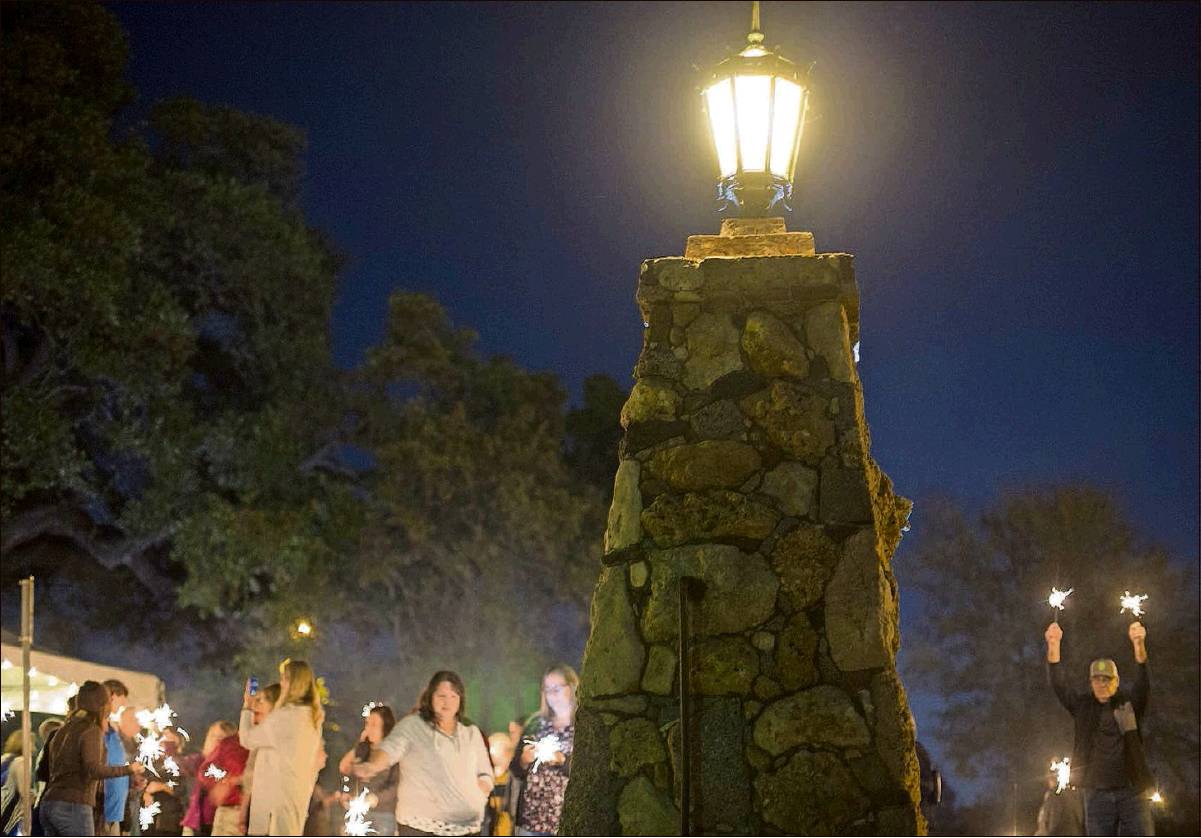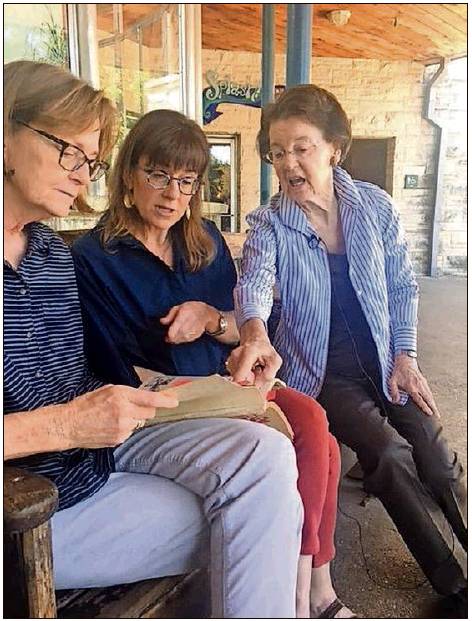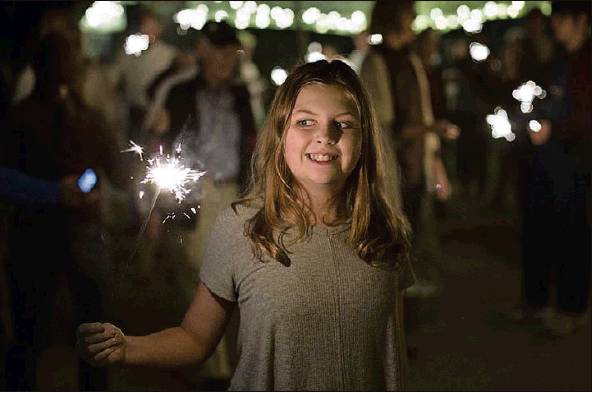Out of the darkness
Two Barton Springs lights are back on for first time in decades.
By Michael Barnes mbarnes@statesman.com
“Two bulbs … two years.”
That’s how architect Emily Little describes the circuitous and eventually rewarding efforts to reilluminate the 1928 stone gateposts at Barton Springs Pool.
On a recent November night, a crowd of about 100 supporters of the Barton Springs Conservancy, a nonprofit advocacy group, gathered with sparklers in hand around the sturdy posts to witness them light up for the first time in decades.
You mean you never noticed those tapered gateposts on William Barton Drive at the entry of the lower parking area at the pool? You are not alone. Visitors often passed right by them without bothering with the formerly dingy stone posts topped by empty metal lamp casings.
It took a lot of teamwork to find out what they were and how they were constructed, and then to restore and clean the geologically varied stones and bring them back to the light each night.
Making it happen
Early in its history, the Conservancy made a list of possible projects to help the city of Austin at the springs, including a big overhaul of the 1947 bathhouse. Following up on that big goal, the nonprofit recently presented a $350,000 check to city officials to complement bond money set aside for the bathhouse efforts, which will include reorienting ticket sales to their original location at the art deco rotunda.
When Conservancy Director J.J. Langston came on board a few years ago, however, the group decided to tackle some of the smaller projects on the list, then gain momentum. After all, it’s not easy executing even the easiest projects on protected parkland while dealing with multiple city offices.
A mother who grew up in Austin but lives in Houston and a daughter who grew up in Houston but now lives in Austin played key roles in this signal effort.
The choice of the gateposts began to take solid shape when it was championed by Conservancy board member Marian Moore Casey, who dedicated the $50,000 campaign to her mother, Nancy Powell Moore, a native Austinite from a famed local family who has nevertheless spent her most productive philanthropic years in Houston.
“Nancy celebrated many University of Texas skip days there in her youth,” Langston says of the honoree and the pool. “She’s the daughter of the Powell Foundation founding directors Kitty King Corbett Powell and Ben Powell (attorney, businessman and investor). The whole family has shared a deep love for the springs.”
In October, this reporter met with Little, Langston, Casey and Moore on benches in front of the pool’s rotunda. It turned into a sort of love fest.
Moore, who speaks in honeyed accents that bring one lineage of Old Austin to spirited life, carried with her all sorts of evocative materials, such as old yearbooks from O. Henry Junior High School.
We talked of Moore’s and Casey’s ancestral homes that came with views of the Capitol in Old Enfield, of grilled cheese sandwiches gobbled at the pool, of taking a course about the Great Plains from distinguished University of Texas historian Walter Prescott Webb, and of “Nightswim,” a play by Steve Moore about Webb and his buddies Roy Bedichek and J. Frank Dobie, the three authors depicted in the “Philosopher’s Rock” statue near the current pool entrance.
Turns out that Moore is in the process of going through a whole room of precious memorabilia and research at her Houston home in preparation to give the most salient archives, much of them about Austin history, to the Briscoe Center for American History.
“Marian gave the contribution for the lampposts restoration as a Mother’s Day gift in my honor,” Moore says. “I was enchanted.”
“Mama has done so much for Houston,” says her daughter, who grew up in River Oaks and now lives in West Lake Hills. “But she adores Austin, and I adore it through her eyes.”
What is that?
“The first thing we did was dig down into the lamp casing,” preservationist Little says of the 1928 gateposts once the project was funded and underway. “We didn’t know the most basic things, such as, were they originally lit by gas or by electricity? Then we discovered some wiring, but where did it go down in the posts, and where did it come out? That was not easy to find out.”
More digging gave Little’s team a sense of where the wiring could lead, but attached to which possible power source? Since the backers wanted the restored lamps to come on at the same time, they considered trenching William Barton Drive to connect the posts directly, but instead dug lines to separate sources, one near the Zilker Zephyr train station, the other near the former Zilker bandstand.
The stone posts presented another conundrum: Why all these differently sourced rocks? Some of the limestone turned out to be related to what was used to face the nearby caretaker’s cottage, itself recently renovated and opened to the public. But it took a consulting geologist, Earle McBride, to identify all the area rocks, leaving a mystery as to why the builders employed such a variety. ATC Contractors stepped up with the sensitive masonry repair and cleaning, and Jesse Malone of Malone Wheeler played an important role in securing proper permits for the project.
Tracking back the origins of things like an actual lamp casing is among any preservationist’s most frustrating challenges. Historical archives — as well as the internet — provide all sorts of clues from old catalogues, receipts, drawings, photographs and descriptions. With the help of local artisans, Little’s team was able to track down the basic pattern of the casings, including links to plants in the Upper Midwest that were located near each other.
Joe Parham of Light Fixture Restoration and Jim Berry of Blue Moon Glass-works, along with workers with the Alterman Electric company, were able to take what were decrepit lamp casings and turn them into a semblance of their 1928 beauty. And they work magnificently.
“The gatepost project speaks to our vision for improving the visitors’ experience throughout Zilker Park,” Langston says. “And it sheds light on the majestic, historic and natural beauty of the city’s most visited and beloved park.”
Contact Michael Barnes at 512-445-3970 or mbarnes@statesman.com. Twitter: @outandabout



